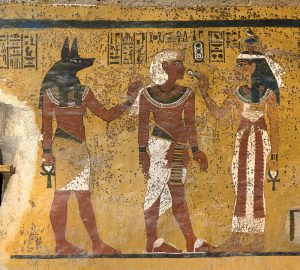One interesting thing in Zimmerman’s article “Activism and Creating a Translational Archaeology of Homelessness” was that some homeless people use graffiti as social commentary and also express themselves by marking public spaces with signs of their heritage. Disappointingly, I could not find much information on the culture surrounding the graffiti of the homeless, (perhaps a new area for archaeology to explore!) but I did discover that people have been leaving their personal mark wherever they go since ancient times.
The best-preserved examples of ancient graffiti come from the ancient Roman cities of Pompeii and Herculaneum, which were buried after the eruption of nearby Mount Vesuvius. One thing that seems clear (at least in these two cities) is that graffiti wasn’t surrounded by the same negative connotations of today. Common in the graffiti of these cities were advertisements and political campaigns, so we can infer that graffiti was more accepted in those times. Also found were doodles and random scrawls that people etched into public places to leave their mark. Much of the graffiti is not unlike some that you would see in a bathroom today, with name-calling and simple messages such as one inscription found in Pompeii that reads: “Gaius Pumidius Diphilus was here.” Clearly, putting our own personal stamp on our world, even if we think it will only be for a short while, is something that dates back to ancient times.
In modern times, graffiti has an intense negative connotation and is seen as dirty, illegal, and disrespectful. However, modern graffiti is not just the vandalism that many think it to be. Of course, graffiti exists that is similar to Pompeii’s name-calling messages, but a lot of it can be considered art. Even “tagging,” or, spray-painting your name on a wall to mark your artistic territory, can be beautiful. In fact, some graffiti hangs in museums today, showing that the streets can be a canvas and graffiti is not simply vandalism. Also, as is mentioned in the Zimmerman article, a lot of graffiti today portrays the artist’s commentary on the social world around them. Perhaps we could learn a lot about a neighborhood from what kind of graffiti is present.
It may not seem like it, but graffiti has a lot to do with archaeology, and much of that connection is still left unexplored. Graffiti is by no means a modern invention, and, in fact, people have been writing similar things on bathroom walls for centuries. Throughout time, people have been doing graffiti in the hopes of leaving a permanent, or at least semi-permanent mark on their world to show that they were there, even if only briefly. Wanting to be remembered is a universal human trait, and by looking at graffiti, both old and new, through the lens of archaeology, we can help uncover how people attempted to immortalize themselves. Although graffiti is not something you can hold in your hand, it is just as telling about a society as ceramics or projectile points.
Sources:
Baird, J. A., and Claire Taylor. Ancient Graffiti in Context. NY, NY: Routledge, 2011. GoogleBooks. Google. Web. 18 Apr. 2017. .
Patel, S. S. 2007. Writing on the wall: the graffiti archaeology project challenges the discipline of archaeology. Archaeology, 60(4): 50–53.
Pilny, Susanna. “Why Ancient Roman Graffiti Is so Important to Archaeologists.” Redorbit. N.p., 05 Jan. 2016. Web. 18 Apr. 2017. .
Zimmerman, Larry J., Courtney Singleton, and Jessica Welch. “Activism and Creating a Translational Archaeology of Homelessness.” World Archaeology 42.3 (2010): 443-54. Taylor and Francis Online. Web. 18 Apr. 2017.
Image sources:
https://s-media-cache-ak0.pinimg.com/736x/66/46/f0/6646f01d5305cfc2fd06b3e6c3f7c895.jpg
http://www.edr-edr.it/edr_programmi/view_img.php?id_nr=144354-1
Additional Info:
Ancient and Modern Graffiti in Rome:
https://www.seeker.com/ancient-graffiti-to-street-art-rome-tells-its-story-1768787772.html
Skid Robot- incorporating the homeless into graffiti :




